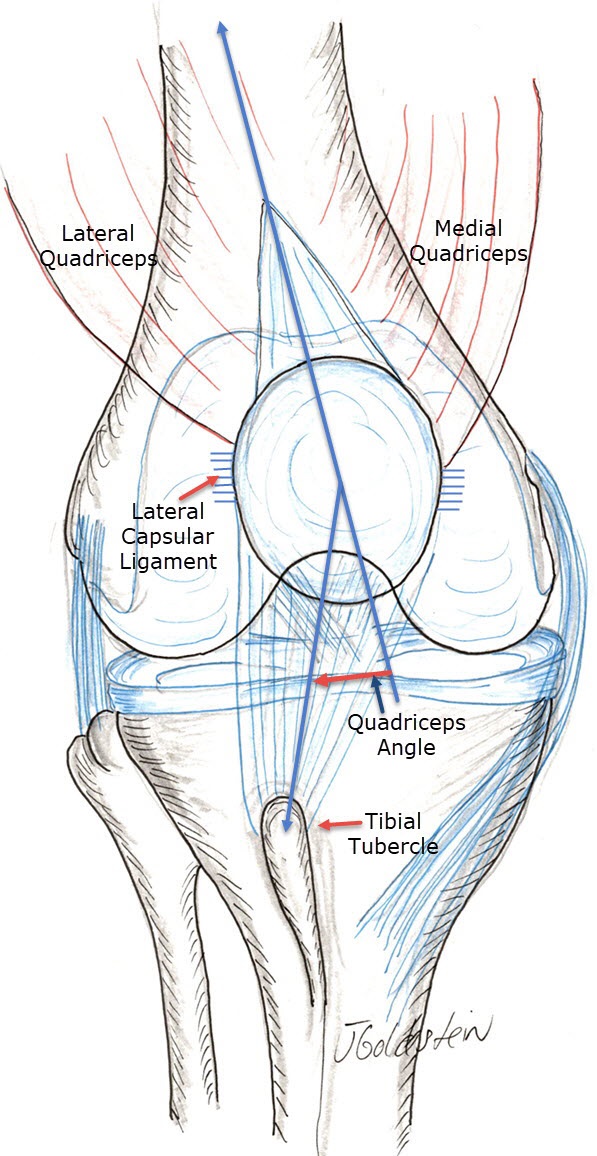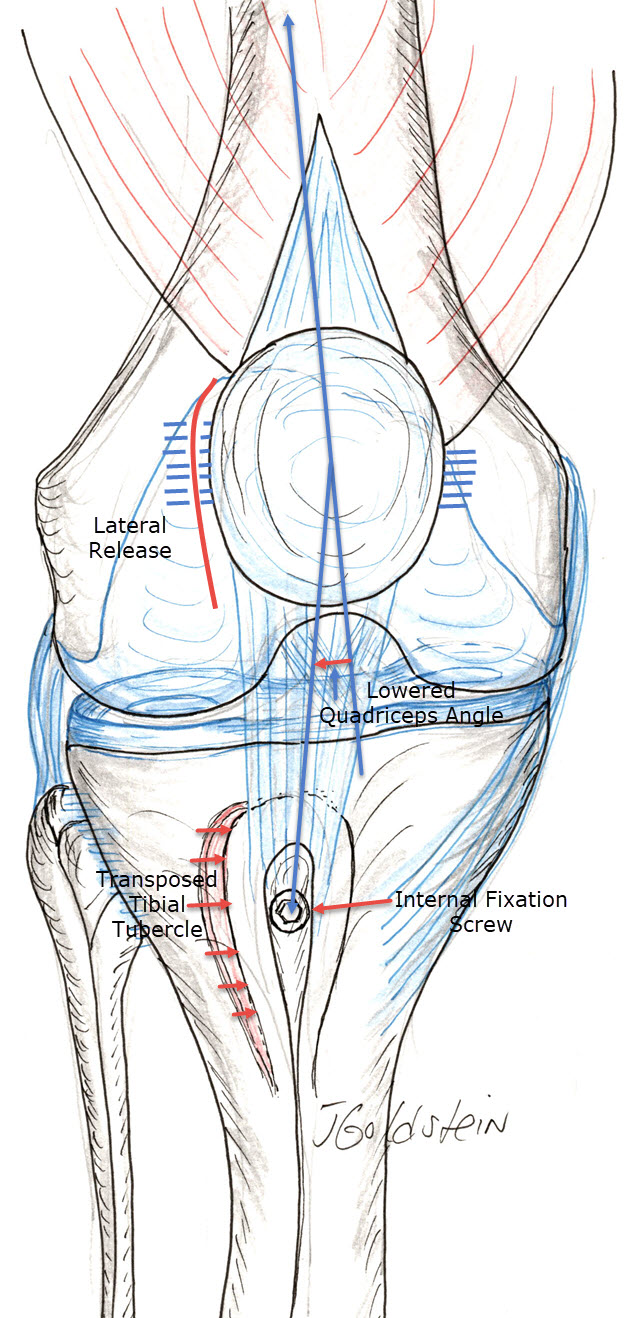Knee Extensor Realignment
General:
Patellar malalignment is relatively common and may lead to chondromalacia at an early age with eventual osteoarthritis of the patella with the chronic overload of the lateral facet of the patella. This is exacerbated by increased body weight especially considering that patellar loading is at least 4 times body weight with activities of daily living. Patellar malalignment can be caused by several factors including a muscular imbalance of the quadriceps and is commonly exacerbated by an increased quadriceps angle (please see drawing) which mechanically increases overload of the lateral patella. The normal tibiofemoral angle contributes to overload and because of typically wider hips in women this condition is more common in women. Patellar overload is more often associated with activities which include high patellofemoral loads such as climbing, cross-country running, jumping and squatting. 
Symptoms:
Symptoms are the same as with chondromalacia but increase with increasing age and increasing patellar wear. Initially, symptoms are mild with swelling and lateral anterior knee pain. Cracking, popping or grating is palpable and may be audible with motion of the knee. As the knee becomes more arthritic in the lateral patella, stiffness occurs with sitting or reduced activities. Weather ache is common as the patella becomes more worn. Debris from the cartilage results and inflammation of the knee and increased swelling and pain.
Diagnosis:
Diagnosis is generally easily made with history and physical examination. Plain x-ray examination is very helpful especially using a skyline or merchant view which visualizes the patellar tracking viewed from the head towards the foot. When done properly, this sees the tilt and subluxation of the patella as well as significant patellar wear. CT scan or MRI may be indicated especially when meniscal or ligament pathology is suspected. These studies may help to visualize the patellar tracking in full extension because x-ray cannot see the patellar tracking with the knee completely straight. This can also be used to measure the Quadriceps Angle. Chondromalacia and maltracking of the patella eventually lead to increased patellar arthritis. Typically, the patient experiences ups and downs in symptoms related to activity and worsen over time.
Treatment:
When conservative treatment including medial quadriceps strengthening, anti-inflammatory medication, weight reduction (if necessary), and patellar bracing have failed to decrease symptoms adequately, realignment of the extensor mechanism may be considered. This is generally performed in younger patients less than 40 years of age. This is primarily because, with arthritis present, there is less reliable improvement with extensor realignment. Multiple factors need to be considered which include: Patient age, weight, underlying arthritic changes, ligament or meniscal injuries, activity level and return to sports. Conservative measures prior to surgical intervention include medial quadriceps strengthening as outlined in my chondromalacia article.
Orthopedic Surgery:
Surgical intervention is considered after conservative measures have been exhausted. Lateral release arthroscopically is usually by itself, of little value and only results in significant improvement when the patella has significant lateral tilt prior to surgery and a relatively normal quadriceps angle. In an effort to lower the quadriceps angle and normalize loading on the patella, tibial tubercle transposition can be undertaken. This is generally combined with an arthroscopic lateral release which allows the patella to centralize even without dramatic tilt prior to surgery. This is generally performed with a quadriceps angle over 20° prior to surgery. To improve the safety of the procedure, it is better to leave the tibial tubercle attached distally. The tibial tubercle is undercut and bent medially using a small incision just medial to the tibial tubercle. Fixation of the tibial tubercle in this position is generally accomplished with a single screw. This is countersunk to avoid prominence and generally the screw can be left without removal. Occasionally, the patella rides much higher than it should, and the patella exits the femoral groove with full extension. In this case, distal transposition may be necessary. This is generally accomplished with 2 screws because of the added concern for solid fixation before healing has occurred. In both instances, significant bone healing generally has occurred by 6 weeks following surgery. During this, the patient remains full weight-bearing but utilizes a hinged brace locked in extension for ambulation only. To improve comfort following surgery, a femoral block is generally employed along with general anesthesia. This makes the anterior knee numb for about 24 hours following surgery allowing the procedure to be performed in an outpatient setting. 
Rehabilitation:
It is imperative to maintain quadriceps strength to avoid atrophy and mal-tracking as a secondary consequence of surgery itself. Typically, the medial quadriceps atrophies more quickly than there rest of the quadriceps muscles. Early range of motion is encouraged either with or without the brace in place and sitting with the brace unlocked. Formal physical therapy is not immediately necessary unless added motivation is required. A stationary bicycle is helpful to regain motion and stimulate quadriceps muscle activity. Resumption of straight leg raise and short arc extension exercises is helpful but should be guided by the surgeon and surgical procedure performed. In general solid fixation of the tibial tubercle allows for rapid mobilization and return to function which ultimately aids patellar tracking and cartilage health. Symptoms following extensor realignment which includes tibial tubercle transposition generally improve for 4-6 months following surgery. Return to work may be rapid depending on the job employed. Certainly, heavy lifting, squatting and climbing should be avoided for several months following surgery. Patients are often sent to formal physical therapy after initial healing of the tibial tubercle or before if necessary. Ultimately, patients are encouraged to return to activity at a gym or home therapy to maintain quadriceps strength and low body weight.
Complications:
As with any surgery, there is a small risk of infection. DVT may be a concern especially in patients who are overweight or who have clotting abnormalities. In general, aspirin at least should be employed for 3 weeks following surgery. In higher-risk patients, Coumadin may be utilized to reduce the risk of DVT dramatically. Likely, the highest risk with this procedure is that it may not completely resolve the symptoms. It is common however for symptoms to improve significantly following surgery and in many cases, they are eliminated.
Compliments of Sports Medicine and Orthopaedics, East Providence, Rhode Island
